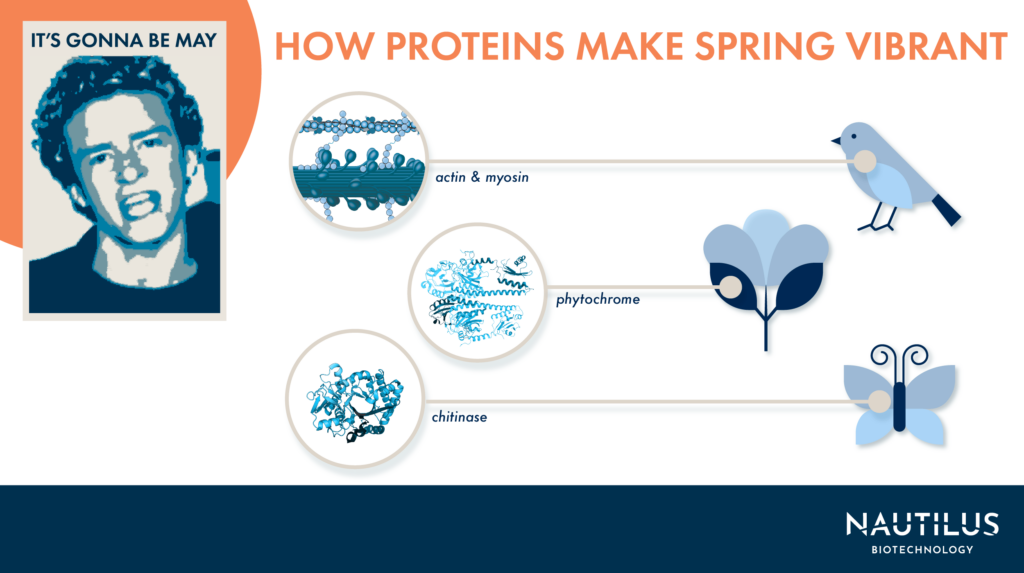
In the immortal words of Justin Timberlake, “It’s gonna be May.” That means there’s no better time (for those of us in the Northern Hemisphere) to reflect on the joys of springtime — which of course includes appreciating the biological mechanisms that make sure spring has properly sprung.
Choose any springtime delight, from singing birds to blooming flowers to beautiful butterflies, and there’s a biological story to be told. Peer inside the cells of any living creature, and you’ll find proteins underpinning its biological functions. Springtime, with all its vibrant colors, sounds, and sights, is an especially fun time to investigate. It’s just another example of the wonders contained inside the proteome, or the collection of all proteins in a sample, cell, or organism.
Here are just a few proteins that play a crucial role in making spring come alive.
Actin and myosin: Proteins that let songbirds sing
Spring heralds the return of migratory birds and their delightful songs. They’re generally singing to attract a mate, but that doesn’t lessen the enjoyment for us humans. Zoom in on their tiny voiceboxes — the syrinx, the vocal organ at the base of their trachea — and you’ll find that proteins are doing a lot of the heavy lifting behind the tricky trills. That’s because the impressive vocals of songbirds are created by the aptly-named Superfast Muscles (SFMs).
SFMs are found in a few other specialized organs, like a rattlesnake’s rattle, and control the contraction and relaxation of birds’ vocal muscles. These tiny high-speed engines are predominantly made of two proteins, actin and myosin, which allow the birds to produce complex songs. Myosin is known as a motor protein, and actin forms filaments along which myosin can bind and unbind. Triggered by motor neurons, these cycles of binding and unbinding generate the force needed for the rapid acoustics in birdsong.
While researchers know a ton about individual proteins like actin and myosin, proteomics methods provide them with a means to look at the many proteins involved in springtime behaviors. For example, scientists at Indiana University recently used proteomics to investigate reproduction and migration in a North American songbird finding a variety of differences between migrating and non-migrating populations. As more accessible and comprehensive proteomics platforms become available, allowing researchers to quantify even more of the proteome, we’ll hopefully gain more understanding of similar amazing natural phenomena.
Check out this episode of our Translating Proteomics series to learn more about the applications of proteomics
Phytochromes: Proteins plants use to detect spring
How do plants know when spring has arrived so they can begin bolstering their foliage and prompting their flowers to bloom? Aside from their complex internal circadian clocks — that’s a story for another day — they have receptors that sense light and track increasing day length. These receptors are phytochromes, complex proteins that can sense light on the red and far-red ends of the spectrum. They are important for every season and therefore almost every stage of a plant’s life.
A lot of what we know about phytochromes, including their evolution and their molecular mechanisms, comes from studying the model organism Arabidopsis thaliana. This small, flowering plant grows quickly and easily in greenhouses and laboratory conditions. How phytochromes trigger changes in plants is still poorly understood, but it’s thought to work through regulation of gene expression. For instance, a 2022 study in PNAS found a link between one type of phytochrome in soybeans and spring flowering time. They discovered that one phytochrome protein in particular, phyA, binds to a protein called LUX to regulate a flowering-suppressor protein called E1. When that suppressor protein stops suppressing, the plant begins to flower.
Future studies in proteomics will be key for revealing the steps of pathways like these. These studies will hopefully enable us to see how the inner workings of plant cells — primarily executed by proteins — change over a season in response to changing day lengths.
Learn more about applications of proteomics in plants.
Chitinases: Proteins for metamorphosis
Every beautiful butterfly you see — and any other insect that went through a molt or metamorphosis as part of its life cycle — hatched a very different animal. Many changes must happen to turn a caterpillar into a butterfly, including not just growing a new body but breaking down the old one. Some of the most important proteins in this process are enzymes called chitinases. These break down chitin, a key component of insects’ exoskeletons.
Researchers can study the mechanisms of metamorphosis with proteomics and reveal the quantities of proteins present at key moments in an insect’s life cycle. For example, researchers from Kansas State University published a study in 2022 reporting a proteomic analysis they conducted on a molting tobacco hornworm – a close relative of the giant green caterpillars that eat your garden tomato plants. They found 121 noteworthy proteins in the caterpillar’s molting fluid, many of which were involved in breaking down chitin, while others were related to immunity and other functions. These findings both improve our understanding of insect biology and give researchers new means of creating pesticides or biological control measures.
Life can move fast, but proteome analysis can grab a biological snapshot of key moments and reveal insights that other forms of inquiry cannot. Whether researchers use those snapshots to appreciate caterpillars or to shield against them, improvements to proteomics analysis platforms will bring speed, quality, and even more potential to the field.
Every little thing (proteins) do
All throughout the natural world, proteins make spring more vibrant. From songbirds and bursting buds to emerging butterflies and pesky pests, proteins have essential roles to play. New tools like the Nautilus Proteome Analysis Platform will make it easier for biologists studying the magic of spring to understand its underlying mechanisms.
This spring, appreciate every little thing proteins do. Don’t let it ever seem enough for you. Because guess what? It’s gonna be May.
MORE ARTICLES


